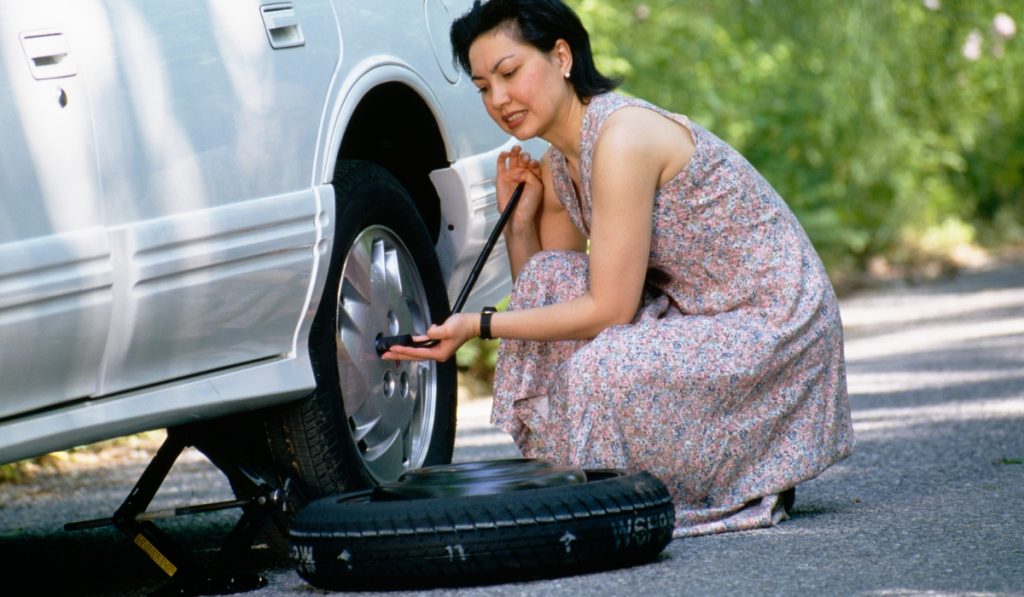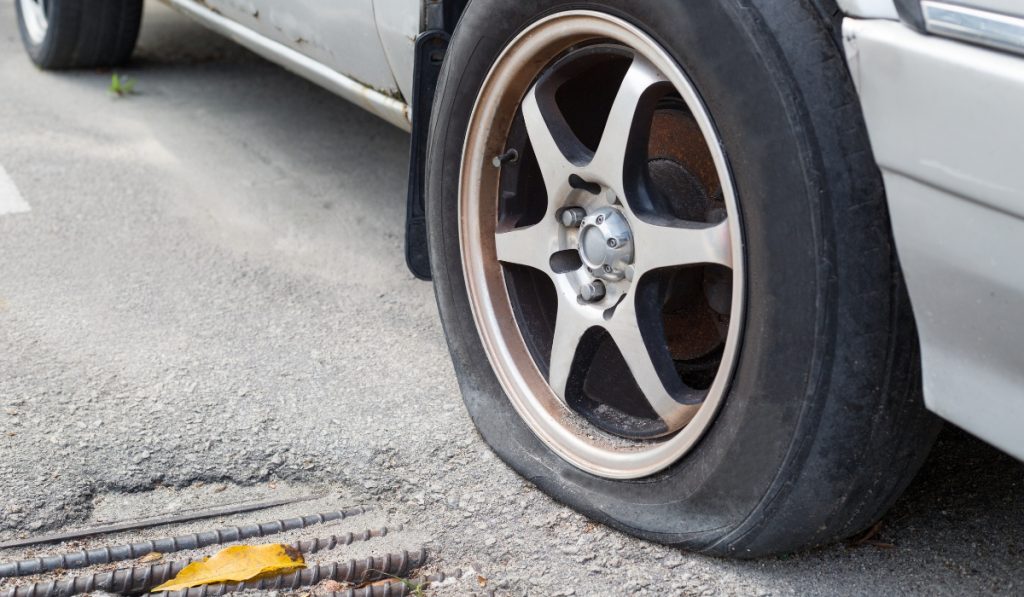Getting a flat tire is one of the most common — and frustrating — roadside problems drivers face. Whether you’re on your way to work, heading out for a road trip, or simply running errands, a flat tire can throw your whole day off.
But knowing how to change a flat tire safely can turn a stressful situation into a manageable one. With the right tools, a little confidence, and some step-by-step guidance, you can get back on the road without having to wait for help.
In this complete guide, we’ll walk you through everything you need to know — from the safety steps you should take before you even touch the tire, to properly installing the spare and getting your vehicle moving again.
What to Do If Your Tire Goes Flat
A flat tire can happen when you least expect it. Well, stay calm first—panicking won’t help. Turn on your hazard lights right away to warn other drivers. Next, try to steer your car to a safe spot. That might be the shoulder or a nearby parking lot. If you’re not sure about changing the tire yourself, call roadside assistance or someone you trust for help. These steps keep you safe and help others notice your vehicle.
Assessing the Situation
Before doing anything, make sure you’re safe. Here’s what you should do:
- Move your car out of traffic as far as possible.
- Put on hazard lights so other drivers see you.
- Place reflective warning triangles behind your car; about 50 feet back works well.
- Engage the parking brake before you start working.
Doing these things lowers the risk of accidents while you fix your tire or wait for help.
Gathering Your Tools
It helps to check your tools before changing a flat tire. You’ll want:
- A spare tire that’s fully inflated.
- A tire jack; read your vehicle owner’s manual to use it correctly.
- A lug wrench for loosening and tightening lug nuts.
- Extra gear like gloves or reflective vests for safety.
Knowing where everything is keeps the process quick and less stressful when you get started.
Preparing to Change Your Tire

Securing the Vehicle
Before you change a flat tire, make sure your car won’t move. Push the parking brake down hard. This keeps your vehicle steady, especially if you’re on a hill or uneven ground.
Turn on your hazard lights right away. They warn other drivers that your car is stopped for an emergency. Use them even if you pull off the road. Park where it’s safe and away from traffic if you can. If not, set up warning cones or reflective triangles behind your car. This helps drivers see you from far away.
These roadside safety measures keep you safe. Be careful when working close to moving cars.
Locating Your Spare Tire and Tools
Look for your spare tire first. It’s usually under the trunk floor or hanging under the back of SUVs and trucks. There are a few types of spare tires:
- Compact (Donut) Spare: Smaller than regular tires and meant for short use at low speeds.
- Full-size Inflated Spare: Same size as normal tires but used only until your real tire gets fixed.
Make sure the spare has air before using it. Next, grab your tools:
- Lug wrench
- Jack handle
- Wheel lock key (if you have one)
- Gloves to keep your hands clean
Having these ready stops you from hunting around once you start changing the tire.
Understanding Your Vehicle’s Jacking Points
Using the jack right is super important. Check your owner’s manual to find exactly where to put it on your car. The jacking points are strong spots made for lifting. Putting the jack in the wrong place can damage parts like skid plates or make things unsafe. Keep these tips in mind:
- Place the jack under the marked jacking point exactly.
- Make sure the ground is flat and firm before lifting.
- Lift slowly while watching if the car stays steady.
- Never go under the car without proper stands holding it up.
Your manual shows these spots for a reason. Follow it so you don’t mess up or hurt yourself during this step. If changing a flat tire feels tricky or you need help fast, Dedicated Towing and Recovery is ready 24/7 to assist you.
Loosening the Lug Nuts
Before you lift your car, you gotta loosen the lug nuts first. This step is key when learning how to change a flat tire safely. Use a lug wrench or tire iron to break them loose while the car sits still on the ground. That way, the wheel won’t spin when you try to loosen them. Here’s what you do:
- Put the lug wrench firmly over a nut.
- Push or pull with steady force, using your body weight.
- Turn it counterclockwise to loosen, but don’t take it off yet.
Don’t try to loosen or hand tighten lug nuts after you lift the car. The wheel could spin and make things unsafe. Always loosen nuts a bit while your car stays steady on solid ground.
Lifting Your Vehicle with the Jack
You need to use a tire jack right for vehicle lifting safety during a tire change. Follow these tips so your car stays steady:
- Park on flat, hard ground, away from traffic.
- Find jack points under your car by checking your owner’s manual—usually near skid plates or strong frame spots.
- Set the parking brake tight before using the jack.
- If you have jack stands, put them under safe support spots once the car is lifted.
- Lift slowly and smooth till there’s enough space to remove the flat tire.
Never get under a raised car without supports like jack stands. Putting the jack in the right places helps protect both you and your car’s body during lifting.
Removing the Flat Tire and Mounting the Spare
After lifting, take off all loosened lug nuts by hand. Then pull off the flat tire carefully. When putting on an inflated spare tire—whether full size or compact “donut” type—do this:
- Match bolt holes up exactly with wheel studs.
- Slide the spare on straight.
- Hand tighten each lug nut evenly in a star pattern to hold it steady.
- Lower your vehicle slowly until the tires just touch ground.
- Tighten lug nuts fully with a wrench using proper torque specs.
Keep in mind that compact spares are only for short-term use and lower speeds. You should fix or replace your regular tires soon after. If you ever feel unsure about changing a flat tire safely, we offer quick roadside help 24/7 — ready to get you moving again fast and safe.
Lowering the Vehicle and Tightening Lug Nuts
After you swap your flat tire for the spare, you need to lower the vehicle carefully. Slowly bring the jack down until the spare tire just touches the ground. This way, the tire holds most of the car’s weight. It keeps your tools safe and helps avoid accidents.
Next, tighten each lug nut by hand as much as you can. Hand tighten first so they fit right without messing up the threads. Then use a wrench to finish tightening. Do this in a star pattern: tighten one lug nut, then jump to the one across from it. This alternate lug nut tightening spreads out pressure evenly on the wheel.
Don’t completely remove all lug nuts at once. When changing tires, loosen or take off a few at a time to keep control. Here’s a quick list:
- Lower jack slowly till tire touches ground
- Hand tighten each lug nut first
- Use wrench in star pattern to fully tighten
- Alternate lug nut tightening for even pressure
- Avoid completely removing all lug nuts at once
Tight lug nuts stop your wheel from shaking while driving. If you’re not sure how tight is enough, check your vehicle’s manual for torque info or ask a pro.
Storing Your Flat Tire and Tools
Once your spare tire is on, don’t forget to stow away your tools right away. Put back the jack, wrench, and any parts you removed into their spots in your car. Keeping everything organized means you’ll find them easily next time.
Then, store your flat tire safely in its original place—usually inside the trunk or under trucks and SUVs. This protects it from damage while driving. Here’s what to do:
- Stow tools like jack and wrench in their storage places
- Put flat tire back where it belongs
- Check spare tire and tools often before trips or drives
If anything feels off during this process or if you need help after changing a flat tire safely, don’t hesitate to call Dedicated Towing and Recovery for support from skilled people ready to assist you anytime.
Driving After a Tire Change

Changing a flat tire safely is just the start. After that, you need to drive carefully. Don’t speed up fast, turn sharp, or slam on the brakes. This helps keep your car steady and protects the new tire.
Stay calm and don’t panic when you’re driving. If you get nervous, it’s easy to make mistakes. Also, if you’re a moderately healthy adult, try not to push yourself too hard right after changing the tire. Feeling tired can mess with your focus.
Before you hit the road again, check that your spare tire has enough air. Then, drive slowly until you find a shop to get it checked or fixed for good. These steps make driving safer after a tire change.
Regular Tire Maintenance Tips
You can stop future flats by taking care of your tires regularly. Here’s a simple checklist:
- Tire Pressure Check: Use a good gauge every month to measure air pressure.
- Tire Inflation Guidelines: Pump tires to match what your car manual or door sticker says.
- Tire Inspection: Look often for cracks, bulges, uneven wear, or stuff stuck in tires.
- Timely Maintenance: Fix leaks fast and swap old tires before they get too worn out.
Paying attention like this keeps your tires healthy and helps avoid surprise flats on the road.
Your Reliable Roadside Assistance Partner
Changing a flat tire safely can be tricky, especially on a busy road. That’s why you need dependable roadside assistance. Dedicated Towing and Recovery offers skilled and professional help any time you need it—day or night.
Here’s what you get when you call us:
- Prompt service with quick response times
- Knowledgeable towing professionals who handle every job with care
- Efficient help that keeps you safe and gets you moving fast
- Emergency roadside assistance whenever things go wrong
- Dependable roadside support for your peace of mind
If you want to learn how to change a flat tire safely, or just need someone to help during an emergency, we’re ready to assist. We know how stressful car trouble can be, so we work hard to make things easier for you.
Contact Us Today for Reliable Towing Services!
Sometimes, fixing the problem yourself isn’t enough. When that happens, trust our towing service in Fort Collins for safe vehicle recovery. Our team knows how to protect your car while moving it. We offer:
- Vehicle recovery done right
- Towing and recovery services for emergencies or scheduled needs
- Friendly support and clear pricing
If your vehicle won’t start or has a bigger problem, give us a call. We’ll provide fast and professional help when you need it most. Don’t wait until trouble hits—save our number now. We’re here anytime you need expert towing services from people who care about keeping drivers safe on the road.
